“My opponent is my teacher, my ego is my enemy” – Renzo Gracie
If you’ve clicked on this article, it most probably means you’ve just started BJJ (yay!), but are struggling with the journey (ahhh, it’ll be ok, we’ve got your back!). It is so common for newbies to feel like they suck and they are not getting good in anything. In fact, it feels worse. Here’s the good news and the bad news. We’ll do the bad news first…Yes, you do suck! The good news – that’s normal. You are not supposed to know a lot, in fact, you aren’t expected to know anything!
This is your turning point here, realising that you still suck even with 6 months under your belt. To put it into perspective, the average time it takes to achieve a black belt in BJJ is 10 years, depending on performance and also satisfying the applicable minimum performance time for each belt (e.g., the minimum time between blue to purple is 2 years). See IBJJF for more information on the graduation system.

Now that you’ve got a perspective on where you are in your BJJ journey, let’s look at some tips to help it suck less and make it more enjoyable.
Tips for surviving the first six months of Jiu-jitsu
Embrace the suck!
We can’t guarantee that there is an expiration date to the suck as the learning journey is full of them, but we recommend for you to get comfortable with the suck to make the journey more enjoyable. After all, it’s in the darkness that the stars shine the brightest. The suck is necessary to push yourself out of your comfort zone to learn and grow.
Focus on your strengths
Instead of focusing on what you are doing wrong, focus on what you are doing right! Just because you are not able to submit your rolling partner or find yourself in the bottom position or less dominant position, does not mean you aren’t getting any better. Focusing on what you are doing right can look like different things. For one, it can look like playing such a good defensive game that your rolling partner has to really work to pass your guard and ‘chase’ that submission.
Tap early
Survive your rolls and mitigate injury risks by tapping out early- this is your rolling bestie! Tapping is a protective communication method- to let your partner know that you are trapped and that they need to let go. A good rule of thumb here is to tap when you’re trapped. Tap early when it’s tight, not when it hurts- more often than not when pain is involved, it’s too far gone. Pain is a sensation that is the body’s protective mechanism, when you feel that sensation, that means you are no longer consciously in control.
Focus on your own benchmark and journey
Your starting point is going to be different to other people’s starting points. If you’re in your 30s and have never done any form of martial arts or any physical activity in a long time, comparing yourself to the bright-eyed and bushy-tailed 19-year-old fellow beginner with a strong strength training base is ridiculous, unrealistic and downright unfair to you. The beauty about BJJ is that everyone’s journey is unique to them. Factors that contribute to and guide someone’s journey includes biomechanics, flexibility, mobility, strength, neuromuscular development, prior injuries etc. This results in certain techniques working better on some opponents compared to others. So how can we measure or keep an eye on our journey? Compare yourself 2-3 months ago to now. What have you learnt since that point? How has your grappling game changed or improved? These are questions to ask yourself periodically. Frankly, we encourage this quick check-in weekly, so that you are in the habit of self-reflecting and acknowledging what and how you are improving. This also keeps the “everyone is getting better but me” beginner blues away!
Jiu jitsu is (one of the) hardest things you’ll ever do
There must be some part of you that thrives on pain and challenges. If not, you wouldn’t have picked one of the hardest sports, both mentally and physically. Knowing this should motivate and inspire you! Many of our BJJ members have reported that practising BJJ has made them more keenly aware of their areas of improvement and motivates them to address them. These areas range from health issues to weight management and injuries. In order to get better at BJJ, one must address these issues- develop health-promoting habits and keep working towards progress. Being consistent with training and attending classes is a fabulous start.
Prioritise Recovery
As with any combat sport, BJJ is physically demanding. After a session of drills and intense rolls, you may feel like you’ve been hit by a truck the following day! This is normal. When you train, you are putting your body under stress and micro trauma. You need to support your body to recover and rebuild.
The recovery trinity is as follows- refuel, reduce and rest. Besides fuelling 2 hours prior to your training with a carbohydrate-rich meal. Your need to refuel after training. The goal of refuelling is to replenish muscle and liver glycogen (energy) stores, repair muscle damage and replace fluid and electrolyte losses. In this post-training meal, prioritise protein and carbohydrates. Ensuring adequate protein intake increases muscle protein synthesis, decreases glycemic responses and increases satiety. Carbohydrate refuelling supports glycogen restoration and typically re-synthesis within the first 24 hours (very quickly within the first few hours).
The second element- reduce. This means reducing stress from both training and non-training workloads. This is best thought out prior to training, such as creating a schedule to ensure that you do not have long periods of high stress without the ability for it to reduce to baseline. When we face stress, cortisol levels elevate, and usually, when the stress trigger is taken away, it returns to baseline. However, when we are faced with elevated stress for long periods of time, we end up with an elevated baseline- this means that the normal level of cortisol is increased. This elevates your risk for cardiovascular, dementia and Alzheimer’s diseases and prolonged high levels disrupt normal bodily processes. So in other words, what we’re saying is to work out a balance that integrates all aspects including periods of downtime.
And lastly, catch them zzzz! Once you have your belly full and had some downtime, it’s time to sleep. According to the Sleep Health Foundation, how much you need to sleep, depends on your age, it decreases as you age and stabilises when you are about 20 years old. It is advised that healthy adults should get between 7-9 hours of sleep and people over the age of 65 should get 7-8 hours per night. Sleep is so important. This is the time when most of the restorative works happen! Get these 3 things right and consistent, you’ll see your recovery improve, resulting in progress in your BJJ game.
Keep a training journal
When you recall techniques to write down, you are forced to step through them again. This is the part of the learning process that many new grapplers miss out on. Doing this helps you to solidify the information. You may choose to keep a log on your phone and type it up, but for us, nothing beats the old-school pen and paper as there is a singular purpose for the notebook and you won’t get distracted by emails, texts or Snapchat! However you choose to do so, just do it! We guarantee you won’t regret it. Besides noting down techniques, you can also note down what went well or what you’d like to improve on, or the new fandagle thing that a higher belt showed you. Do this straight after class and from time to time look back at your notes.
Have a blast!
The whole point of starting a new hobby, be it a craft or sport is to have fun! Just a word of warning, BJJ can become addictive and potentially consume all of your time. If you’re single and have nothing else better to do, great, but if you have a partner or spouse, this can be a point of friction. Our recommendation here is to encourage your partner/ spouse to tag along to some classes (if they are keen), show them a couple of moves at home (gently) and 100% bring them to the social events so that they have the opportunity to interact and join in at some level, maybe even get to know some of the other partners too!
Check the ego at the door and enjoy the journey as it is yours and yours alone! Remember, BJJ is really just a bunch of people rolling around, and if you do gi, in PJ’s.
References
International Brazillian Jiu-jitsu Federation. (n.d.). IBJJF graduation system. IBJJF. Retrieved July 17, 2022, from https://ibjjf.com/graduation-system
Campbell, B., Kreider, R. B., Ziegenfuss, T., La Bounty, P., Roberts, M., Burke, D., Landis, J., Lopez, H., & Antonio, J. (2007). International Society of Sports Nutrition position stand: protein and exercise. Journal of the International Society of Sports Nutrition, 4(1), 8. https://doi.org/10.1186/1550-2783-4-8
Ouanes, S., & Popp, J. (2019). High Cortisol and the Risk of Dementia and Alzheimer’s Disease: A Review of the Literature. Frontiers in Aging Neuroscience, 11. https://doi.org/10.3389/fnagi.2019.00043
Suni, E. (2021, March 10). How Much Sleep Do We Really Need? | National Sleep Foundation (A. Singh, Ed.). Sleepfoundation.org. https://www.sleepfoundation.org/how-sleep-works/how-much-sleep-do-we-really-need
Toledo, J. B., Toledo, E., Weiner, M. W., Jack, C. R., Jagust, W., Lee, V. M. ‐Y., Shaw, L. M., & Trojanowski, J. Q. (2012). Cardiovascular risk factors, cortisol, and amyloid‐β deposition in Alzheimer’s Disease Neuroimaging Initiative. Alzheimer’s & Dementia, 8(6), 483–489. https://doi.org/10.1016/j.jalz.2011.08.008



